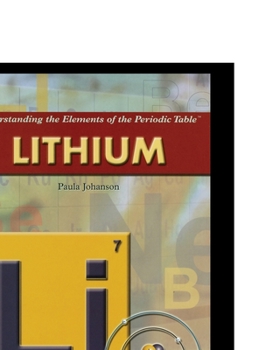Lithium
Select Format
Select Condition 
Book Overview
Lithium, comes from the Greek word lithos, meaning "stone." When alloyed with other elements, such as aluminum or other metals, lithium makes alloys strong and light for use in airplanes and... This description may be from another edition of this product.
Format:Paperback
Language:English
ISBN:1435837762
ISBN13:9781435837768
Release Date:January 2007
Publisher:Rosen Publishing Group
Length:52 Pages
Weight:0.27 lbs.
Dimensions:0.1" x 8.0" x 10.0"
Age Range:8 to 12 years
Grade Range:Grades 3 to 7
Customer Reviews
1 rating
The 31st most abundant element on our world.
Published by Thriftbooks.com User , 14 years ago
I've read several books in the "Understanding the Elements of the Periodic Table" series for young adults (YA), and this volume on the third element opens up with the usual introduction to the periodic table, especially concerning the positions of metals within it, since lithium is a silvery-white alkali metal. It is softer than talc and reacts readily with air and water, so it is never found in its pure form on the Earth's surface. It is the 31st most abundant element on our world. The cosmological lithium discrepancy would have been an interesting discussion topic, but this series of YA books doesn't touch upon the origin of elements in the Big Bang or in stellar interiors, or through a process called cosmic ray spallation (important for lithium.) Read Marcus Chown's The Magic Furnace: The Search for the Origins of Atoms for a lucid account of the origins of elements. Meanwhile, this book covers the many uses of lithium in batteries, as a medication, and in lubricants, cement, and sunglasses. There is even tongue-in-cheek commentary on the starship Enterprise's dilithium crystals. I am enjoying these 48-page books on the elements, as each book `personalizes' a particular element for me and makes it easier to remember. The only place where the author could have been a bit more precise is when she says, "...neutrons contribute as much as or more than the protons to the mass of the lithium atom." Neutrons will always contribute more mass to the lithium atom, since they are slightly heavier than protons and lithium has either 3 or 4 neutrons, and only 3 protons. For those readers who would like to further explore the periodic table, I can enthusiastically recommend Nature's Building Blocks: An A-Z Guide to the Elements (2003) by John Emsley and The Periodic Table: Its Story and Its Significance (2007) by Eric R. Scerri. For more general reading on the periodic table and how it sparked the interest of young scientists, two outstanding autobiographies are available: Uncle Tungsten: Memories of a Chemical Boyhood (2001) by Oliver Sacks and The Periodic Table (1975) by Primo Levi.






